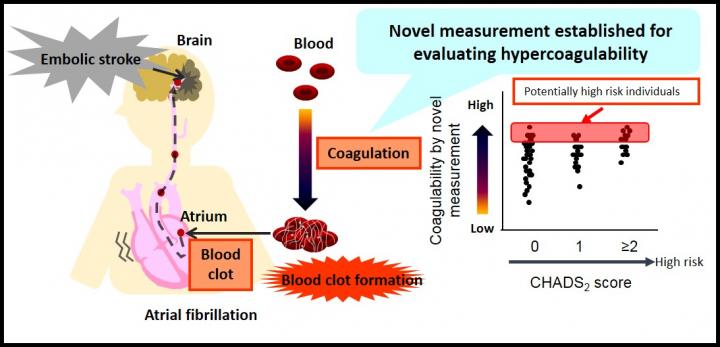Blood coagulation detector may help in monitoring stroke risk

Assessing embolic stroke risk by measuring blood coagulability. Credit: Department of Biofunctional Informatics, TMDU
Atrial fibrillation (AF) causes an irregular and sometimes fast heart rate, and is a common risk factor for stroke. To estimate this risk in AF patients and determine the requirement for anticoagulation therapy, the CHADS2 predictive score is used.
Because some parts of this score are also associated with atherosclerosis risk and increased blood coagulability, a high score has been proposed as linked to hypercoagulability (an increased tendency for blood clotting) in both AF and non-AF patients. However, this association has not been fully investigated, partly owing to the lack of a sensitive means of detection.
A research team from TMDU used a highly sensitive technique to measure small changes in blood coagulation, and found hypercoagulability in non-AF patients with high CHADS2 scores. The study was recently reported in PLOS ONE.
Several physical and chemical factors affect blood clotting, some of which can be measured over time to determine blood coagulability and the likelihood of clot formation. Dielectric blood coagulometry (DBCM) is a recently developed test that measures changes in the dielectric permittivity of whole blood, representing clumping of red blood cells.
The researchers used DBCM to detect changes in the dielectric permittivity of whole blood at 10 MHz. Comparisons between untreated blood and that with added heparin (a blood thinner) or tissue factor (a blood-clotting accelerator) enabled derivation of a coagulability index.
“We calculated the end of acceleration time (EAT) as an index of coagulability from temporal changes in dielectric permittivity,” coauthor Satomi Hamada says. “This value reduced when tissue factor was added, and increased with heparin present. It was also sensitive enough to detect small changes in coagulability, particularly in hypercoagulability.” EAT also boasts high reproducibility and reliability.
The researchers found that patients receiving warfarin had a significantly longer EAT than those without, confirming the anticoagulation effect. They also showed that patients with a high CHADS2 score had a significantly shorter EAT that represented hypercoagulability compared with patients with lower CHADS2 scores. “Intriguingly, EAT varied widely in patients with CHADS2 scores of 0 or 1,” lead author Yuki Hasegawa says. “This suggests that DBCM can identify high risk of thrombosis even in patients with low CHADS2 scores.”
###
The article, “Novel dielectric coagulometer identifies hypercoagulability in patients with a high CHADS2 score without atrial fibrillation” was published in PLOS ONE at DOI:10.1371/journal.pone.0156557
Media Contact
All latest news from the category: Health and Medicine
This subject area encompasses research and studies in the field of human medicine.
Among the wide-ranging list of topics covered here are anesthesiology, anatomy, surgery, human genetics, hygiene and environmental medicine, internal medicine, neurology, pharmacology, physiology, urology and dental medicine.
Newest articles

Combatting disruptive ‘noise’ in quantum communication
In a significant milestone for quantum communication technology, an experiment has demonstrated how networks can be leveraged to combat disruptive ‘noise’ in quantum communications. The international effort led by researchers…

Stretchable quantum dot display
Intrinsically stretchable quantum dot-based light-emitting diodes achieved record-breaking performance. A team of South Korean scientists led by Professor KIM Dae-Hyeong of the Center for Nanoparticle Research within the Institute for…

Internet can achieve quantum speed with light saved as sound
Researchers at the University of Copenhagen’s Niels Bohr Institute have developed a new way to create quantum memory: A small drum can store data sent with light in its sonic…





















